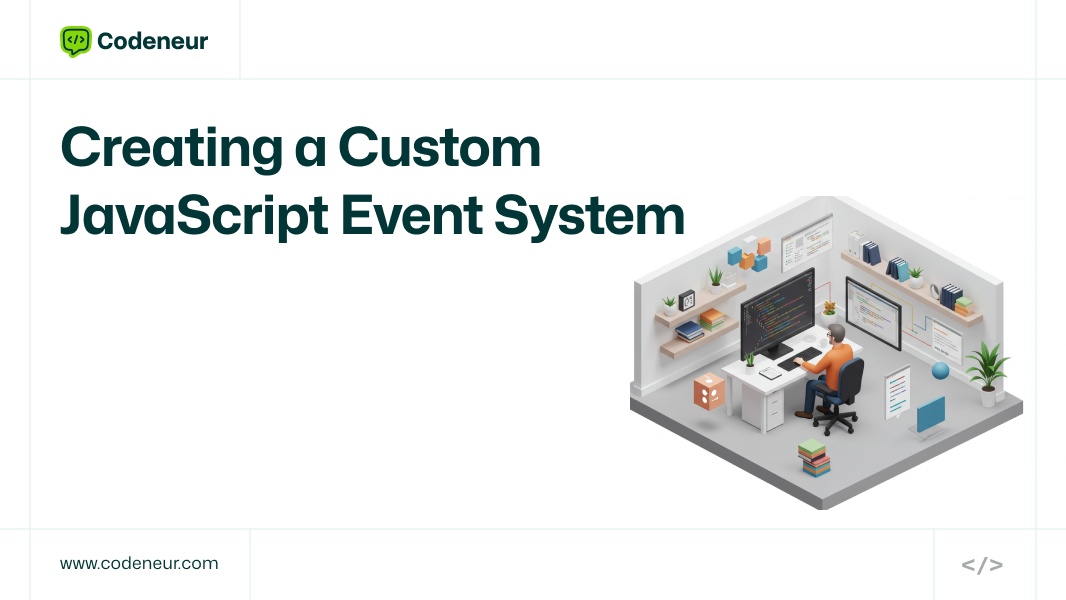Creating a custom event system for your web apps can do a great deal to enhance the way you handle interactions. Creating a Custom JavaScript Event System provides you with total control over how events fire, listen, and are acted upon.
But there might be situations when the built-in system is not enough or you want more flexibility in the flow of events within your application. This is when building a custom event system becomes useful.
In this post, we’re going to step through creating your own custom event system in JavaScript. We’re going to address creating events, binding listeners, emitting events, and removing listeners.
Designing a Custom JavaScript Event System
JavaScript offers integrated event handling strategies, including addEventListener, enabling us to reply to user interaction such as mouse clicks, keystrokes, or form submission.
We’re going to learn the use cases along the way as well as the advantages of creating such a system.
Why Build a Custom Event System?
Let’s talk about why you would even want to create your own event system before we dig into the code. These are some situations in which a custom event system can come in handy
- Decoupling components: With a custom event system, components can talk to one another without having direct pointers, so your code is more modular.
- Custom behaviors: Occasionally, you’ll want to create your own events that don’t fit into the standard DOM events. This might be application-specific events, such as when a user finishes a multi-step workflow or when some data has changed.
- Better control: With a custom event system, you have control over how events are handled, including how they are triggered, canceled, and propagated among listeners.
With these benefits in mind, let’s create a simple custom event system from the ground up!
Step 1– Building the Event System
The foundation of any event system is registering event listeners, firing events, and un-registering listeners. Let’s begin by creating a class for our own custom event system.
Event System Class
Explanation of the Methods
- on(event, listener): Adds a new listener function for an event. If there are no listeners for the event, a new array is added to hold the listeners.
- off(event, listener): Removes a particular listener from an event. If the listener is present in the array of the event, it’s removed.
- emit(event, .args): Fires the event and calls all connected listeners with any given arguments (.args). You can pass more than one argument to the listeners using the spread syntax.
Example Usage
Having our simple event system, let’s use it
Here, we instantiate an instance of EventEmitter, attach some listeners, emit events, and remove listeners if necessary. The emit() function provides you with flexibility to pass any arguments to the listeners, allowing you to pass data along with events.
Step 2– Adding Additional Features to the Event System
Handling Once-Only Events
On occasion, you may wish to fire an event listener once and then have it be removed automatically. We can add this by introducing a once option.
Usage of Once
Explanation of once Method
- once(event, listener): This method guarantees that the listener is removed after being called once. It achieves this by encapsulating the listener in a function that removes itself after being called.
Step 3: Error Handling and Additional Features
The simple event system we’ve developed until now is sufficient for most use cases, but in advanced applications, you may need to catch errors or guarantee execution order for listeners.
You can add features to the event system such as error handling and ordered execution by priority.
As an example, you could add a feature to capture and handle errors while executing events
This allows other listeners to still be run even if a single listener has thrown an error.
Step 4: Real-World Use Cases
Custom event systems find their utility best in frameworks and big applications. Below are some practical instances where custom event systems can be used
- Custom Notifications: You can create a notification system in which various sections of your app can fire custom events, and other sections can listen for those events and show notifications.
- State Management: Using a basic pub/sub (publish/subscribe) system for state change management between components without dependencies.
- UI Components: Event systems are ideal for bespoke UI components (such as modals, dropdowns, or tabs) that should emit and respond to state changes or interactions from anywhere in the app.
Conclusion
Building a bespoke JavaScript event system gives you more flexibility and authority over how your application reacts to user input or internal events.
Knowing how events are emitted, listened for, and removed lets you build decoupled, modular code that’s more maintainable and scalable.
Whether you’re building a simple notification system, a complex state management solution, or just want more control over event flow, a custom event system can help simplify communication between different parts of your application.
If you want to immerse yourself more in full-stack development, there is a wide-ranging Full Stack Course by Codeneur that will give you hands-on skills in JavaScript and other technologies.
Key Takeaways
- Custom event systems give flexibility: total control over the triggering, listening, and propagation of events.
- Decoupled components: components can communicate without direct references, making the code more modular.
- Custom event behaviors: create application-specific events beyond just standard DOM events.
- Better control: you can manage event propagation, cancellation, and execution order.
- Once-only listeners: the once method will ensure that your listeners are fired once and removed.
- Error handling: one listener failing doesn’t prevent others from executing.
- Real-world case use: notifications, state management, and dynamic UI components.
- Scalable and maintainable: building modular, scalable, maintainable code for complex apps.

